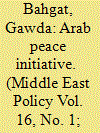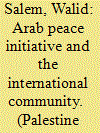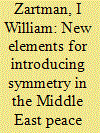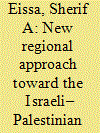| Srl | Item |
| 1 |
ID:
087370


|
|
|
|
|
| Publication |
2009.
|
| Summary/Abstract |
In the second half of the 2000s, several
unprecedented developments in the
Arab-Israeli confl ict have highlighted
the potential of a dramatic alteration
of the Middle East's strategic landscape.
King Abdullah of Saudi Arabia has sponsored
a world conference on dialogue
among various faiths and cultures, including
Islam, Christianity and Judaism. It
opened with a meeting in Madrid, Spain,
in July 2008, and a follow-up session
was held under the auspices of the United
Nations in New York City the following
November. The list of participants in this
latest meeting included the kings of Saudi
Arabia and Jordan; the emirs of Kuwait
and Bahrain; the presidents of Israel, the
United States, Finland, Pakistan and Lebanon;
and the prime ministers of Britain,
Qatar, Morocco, the United Arab Emirates,
Djibouti and Egypt.
|
|
|
|
|
|
|
|
|
|
|
|
|
|
|
|
| 2 |
ID:
138329


|
|
|
|
|
| Summary/Abstract |
With the ongoing stalemate on the Israeli-Palestinian bilateral track, all who actively seek peace still see the Arab Peace Initiative (API) of 2002 as a potential point of departure for breaking the impasse, contingent on the Israeli government’s readiness to accept the API as a basis for discussion. The draft United Nations Security Council resolution circulated by France refers to the API; there are reports that the United States may be developing a new API-based plan for peace; and the European Union has shown interest on many occasions in moving in that direction. Many Israeli parties have developed API-based plans for peace such as MK Yaakov Peri (Yesh Atid), the Zionist Camp, Meretz and others. Even Foreign Minister Avigdor Lieberman wants to distort the API’s content by calling for normalizing relations with the Arab countries without withdrawing from the Palestinian and Arab territories occupied in 1967.
|
|
|
|
|
|
|
|
|
|
|
|
|
|
|
|
| 3 |
ID:
111734


|
|
|
|
|
| Publication |
2012.
|
| Summary/Abstract |
The Arab Peace Initiative (API) of March 2002 was intended to revolutionize the Middle East. The new regional agenda offered by the 22 countries of the Arab League represented a historical paradigmatic shift in the relations between Israel and the Arab world. More than a century of conflict between the Arab world and the Zionist movement were to come to an end. If we were to summarize the provisions laid out in the League's decision in Beirut, the fundamental principles are quite simple: All Arab countries would normalize their relations with Israel in return for full Israeli withdrawal from the Golan Heights, the Gaza Strip and the West Bank (including East Jerusalem). An independent Palestinian state would be established, and a just and agreed solution would be found for the Palestinian refugee problem, in accordance with Resolution 194 of the United Nations General Assembly. All Arab countries would consider the Arab-Israeli conflict to be over and done, enter into peace agreements with Israel and provide security to all countries of the region. All League members accepted the proposal, and it was also endorsed by all 57 states of the Organization of Islamic Cooperation (all Muslim countries) at their meeting in Tehran.
|
|
|
|
|
|
|
|
|
|
|
|
|
|
|
|
| 4 |
ID:
158137


|
|
|
|
|
| Summary/Abstract |
This issue contains an examination of Palestinian-Israeli negotiations with an effort to break through the deadlock strategically. It analyzes the past record of failure and addresses the basic problem of asymmetry. Despite the solutions that have been advanced for all the specific issues, it is the forward-looking matter of trust that is the impediment to productive negotiations. The declaration of a Palestinian state and its recognition by the international community are now the basic elements necessary to break the asymmetry of the parties. A second element – allegedly favored by the Trump administration – is to reduce a symmetry by enlarging the playing field to include surrounding states, as proposed in the 2002 Arab Peace Initiative.
|
|
|
|
|
|
|
|
|
|
|
|
|
|
|
|
| 5 |
ID:
162645


|
|
|
|
|
| Summary/Abstract |
There are two principal reasons behind the lack of success in reaching a final peace agreement between the Israelis and the Palestinians, namely, the malfunctioning negotiations’ framework from one side and the complexity of the negotiated issues from the other. This article is mainly addressing the bilateral framework’s flaws when it comes to the Oslo accords and the way the two negotiating parties have perceived them. It is an attempt to overhaul the existing Oslo peace process and not to create a new one. Oslo process has become entrenched over more than twenty years of different practices and legal realities. The article is also introducing a negotiating framework that combines the benefits of a multilateral regional track to the Oslo process aiming to redress the latent structural flaws. It is intended not to tackle the final status issues, as there is a plethora of literature doing so. The extensive focus on those complicated issues without redressing the process’ structural flaws has led partially to the current stalemate. The role of any mediator or external partner is not to solve those issues on behalf of the principal parties, but to work on the negotiating framework and the process itself.
|
|
|
|
|
|
|
|
|
|
|
|
|
|
|
|